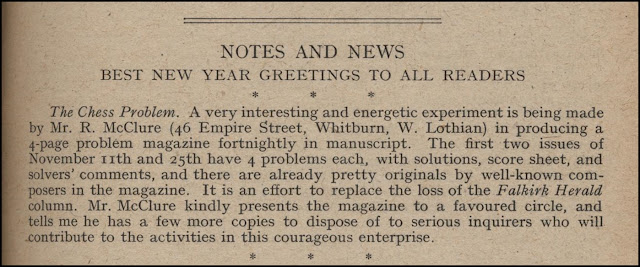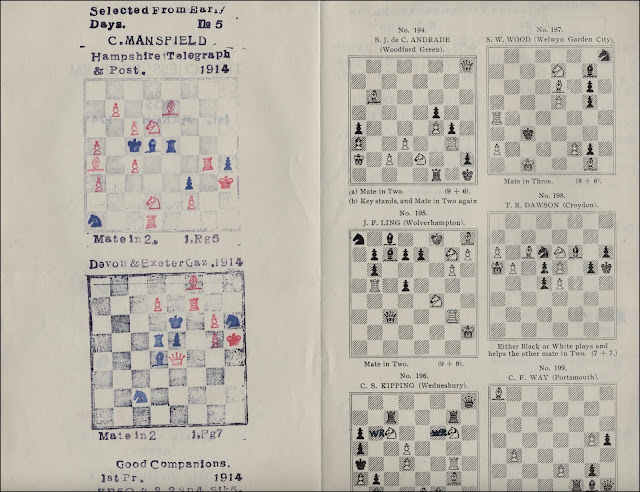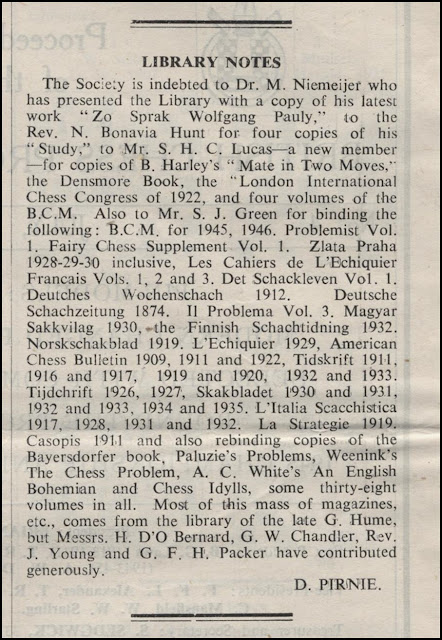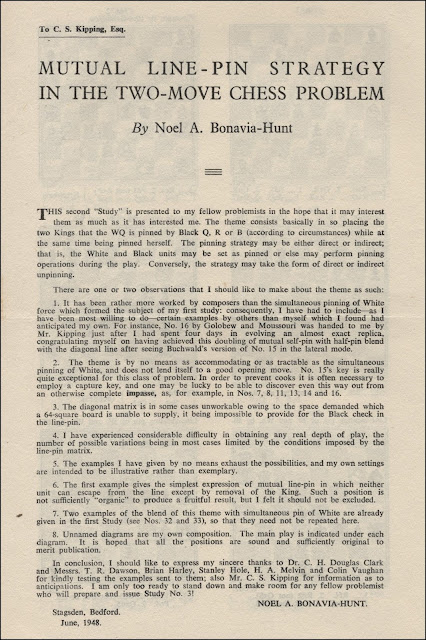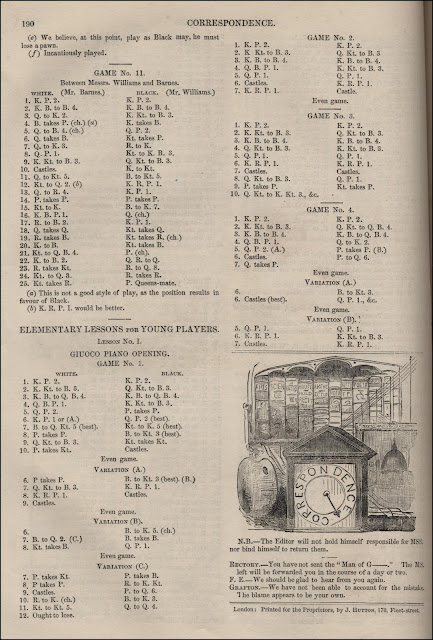The Chess Problem, edited and published by Robert McClure of Whitburn, West Lothian, commenced in November 1942 and ran for 108 issues up to March 1948.
I have recently acquired all issues from No. 34 for 16th February 1944 up to No. 108 for March 1948 of this fortnightly magazine and, as this is almost impossible to find, I will describe it in some detail.
Further information on this magazine can be found in an article by John Beasley in The Problemist for May 2003, which has been reproduced in the biographies section of the chessscotland website. The Chess Problem was launched with the aim of filling the gap created by the suspension of the chess column in the Falkirk Herald following the death of that column's editor in 1942, and, in fact, this was the only British chess periodical which commenced operations during the war years.
The Chess Problem is also briefly mentioned in T. R. Dawson's Problem World article in The British Chess Magazine, January 1943, page 21, and in C. S. Kipping's Problem Pages in Chess, June 1943, page 149.
The early issues consisted of a single sheet of paper folded in half to create four pages, and, unfortunately, the paper size is slightly larger than foolscap so that my scans are cropped.
Issues 34 to 86 were part printed and part duplicated with hand-stamped diagrams and text, or perhaps each copy was individually hand-stamped.
Pages from issue No. 34:
Pages from issue No. 34:
The basic layout of the early issues was a hand-stamped end game study on the printed front/title page, with a stamped issue no. and date. Some problems Selected From Early Days were stamped on page 2, six printed problems appeared on page 3, and hand-stamped solutions and corrections to earlier problems were included on page 4.
From No. 41 an additional leaf was attached inside increasing the size to 6 pages, this included an End Games article by M. W. Paris and the end game study no longer featured on the front page. However, Nos. 57 to 75 (January to September 1945) reverted to four pages and Paris's End Games articles moved to page 2.
Issue No. 41:
Issue No. 41:
It was announced in Issue No. 62 that M. W. Paris was making a collection of Endings on the lines of the "White-Hume" Problem Collection, but I have been unable to find any further details of this.
Issue No. 65 carries the first of many regular adverts by Dr. A. Buschke, the New York chess literature dealer, while No. 66 advertises The Chess Correspondent, Official Magazine of the Correspondence Chess League of America, noting that this includes master and correspondence games, fully annotated by Fred Reinfeld.
There was a hiatus in publication of three months between issue No. 76, 1st October 1945, and issue No. 77, 9th January 1946, and there was only one End Games article between October 1945 and June 1946 due to the long serious illness of Mr. Paris.
The editor published a letter to his readers in issue No. 81, March 1946, appealing for financial contributions to assist with the purchase and installation of a printing press. McClure noted that the present circulation was 160, and increasing with every issue. He promised to double the size of the magazine with the new press.
The appeal was successful and from No. 87, 29th May 1946, a fully printed eight page magazine was produced in a slightly smaller format (which now fits in the scanner).
Issue 87:
The magazine was further improved from issue No. 91 onwards with proper covers for the first time, these were variously blue and pink. Issue No. 91 also announced the International Composing Tourney for End Games, conducted by L'Italia Scacchistica, to be judged by Dr. Jean Mennerat, the well known French chess bibliophile, and R. Bianchetti of Italy.
Publication became erratic from August 1946, with up to six weeks between issues. From 1st November 1946 the magazine was produced twice monthly and then monthly from No. 101, February 1947 to No. 105, June 1947. There was then a gap of seven months to No. 106 for January 1948 owing to a break-down in the editor's health due to overwork, and only two more issues were published, ending with No. 108 in March 1948.
Issue No. 106 had announced a new series on Chess Problemists of the World but this appeared only once, in No. 107, with problems by G. Mott-Smith of New York.
There is no indication in the final issue that this would be the last and I can find no further information about Robert McClure or the reasons for the abrupt discontinuation of his magazine. A total of 802, mainly original, problems from around the World were published during the magazine's life and these included help-mates, retractors, fairy problems etc. Only solutions up to 740 had been printed before publication ceased.
Pages from the final issue:
These magazines came with a sheaf of papers which mainly include solvers comments on previous problems, and I assume that these were distributed with the relevant issue. Some of these have lists of books for sale by Dr. A. Buschke printed on the back. There is also an eight page leaflet on Fairy Chess Problems which appears to be written in McClure's hand.
Availability.
The National Library of the Netherlands, Koninklijke Bibliotheek, has a full run, with the editor misnamed as MacClure, but I cannot trace this in the Cleveland Public Library. The British Library has issue No. 3 and most issues from 30 to 106 (lacking 40, 75, 104, 107, 108). As noted in John Beasley's article in The Problemist, the British Chess Problem Society also has a full set.
© Michael Clapham 2017
There was a hiatus in publication of three months between issue No. 76, 1st October 1945, and issue No. 77, 9th January 1946, and there was only one End Games article between October 1945 and June 1946 due to the long serious illness of Mr. Paris.
The editor published a letter to his readers in issue No. 81, March 1946, appealing for financial contributions to assist with the purchase and installation of a printing press. McClure noted that the present circulation was 160, and increasing with every issue. He promised to double the size of the magazine with the new press.
The appeal was successful and from No. 87, 29th May 1946, a fully printed eight page magazine was produced in a slightly smaller format (which now fits in the scanner).
Issue 87:
The magazine was further improved from issue No. 91 onwards with proper covers for the first time, these were variously blue and pink. Issue No. 91 also announced the International Composing Tourney for End Games, conducted by L'Italia Scacchistica, to be judged by Dr. Jean Mennerat, the well known French chess bibliophile, and R. Bianchetti of Italy.
Publication became erratic from August 1946, with up to six weeks between issues. From 1st November 1946 the magazine was produced twice monthly and then monthly from No. 101, February 1947 to No. 105, June 1947. There was then a gap of seven months to No. 106 for January 1948 owing to a break-down in the editor's health due to overwork, and only two more issues were published, ending with No. 108 in March 1948.
Issue No. 106 had announced a new series on Chess Problemists of the World but this appeared only once, in No. 107, with problems by G. Mott-Smith of New York.
There is no indication in the final issue that this would be the last and I can find no further information about Robert McClure or the reasons for the abrupt discontinuation of his magazine. A total of 802, mainly original, problems from around the World were published during the magazine's life and these included help-mates, retractors, fairy problems etc. Only solutions up to 740 had been printed before publication ceased.
Pages from the final issue:
These magazines came with a sheaf of papers which mainly include solvers comments on previous problems, and I assume that these were distributed with the relevant issue. Some of these have lists of books for sale by Dr. A. Buschke printed on the back. There is also an eight page leaflet on Fairy Chess Problems which appears to be written in McClure's hand.
Availability.
The National Library of the Netherlands, Koninklijke Bibliotheek, has a full run, with the editor misnamed as MacClure, but I cannot trace this in the Cleveland Public Library. The British Library has issue No. 3 and most issues from 30 to 106 (lacking 40, 75, 104, 107, 108). As noted in John Beasley's article in The Problemist, the British Chess Problem Society also has a full set.
© Michael Clapham 2017

